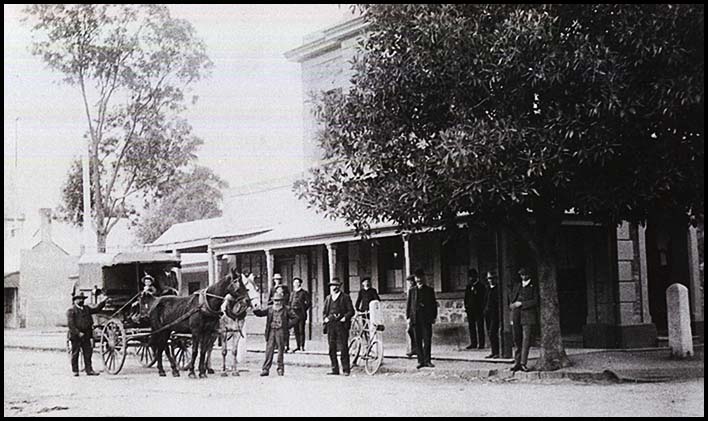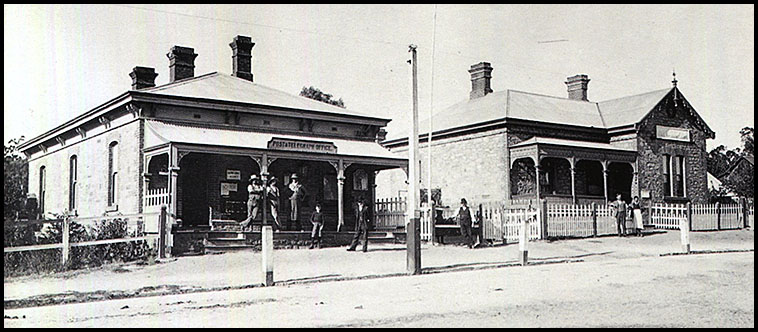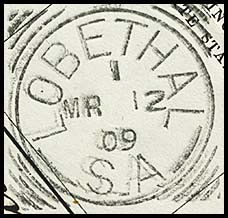TOs in area east of Adelaide to the Murray and north-east to Angaston.
- Home, index, site details
- Australia 1901-1988
- New South Wales
- Overview of NSW
- Telegraph lines
- Telegraph Offices
- Date stamps
- Forms
- Envelopes
- Rates
- Stamps
- Queensland
- Overview of Qld
- Telegraph lines
- Telegraph offices
- Date stamps
- Forms
- Envelopes
- Rates
- Stamps
- South Australia
- Overview of SA
- Telegraph lines
- Telegraph Offices
- Date stamps
- Forms
- Envelopes
- Rates
- Stamps
- Tasmania
- Overview of Tasmania
- General developments
- Reports
- Organisation
- Telegraph lines
- Telegraph Offices
- Date stamps
- Railway lines
- Forms
- Envelopes
- Rates
- Stamps
- Overview of Tasmania
- Victoria
- Overview of Vic.
- Telegraph lines
- Telegraph offices
- Date stamps
- Forms
- Envelopes
- Rates
- Stamps
- Ephemera
- Western Australia
- Overview of WA
- Telegraph lines
- Telegraph Offices
- Date stamps
- Forms
- Envelopes
- Rates
- Stamps
|
The Telegraph Office opened on 7 March 1866. In October 1865, the line was being pegged and the erection of the poles was about to start. In the South Australian Register of 9 July, 1868, the following small item appeared: "The Telegraph Office has lately been robbed twice of small sums of money; but there is a mystery about the affair, so that we can say little about it". In the House of Assemby on 13 October 1880, Mr. Basedow asked "whether the Government would, now the necessary money had been passed in the Estimates, go on without any unnecessary delay with the erection of the Post & Telegraph Office in Angaston. The Commissioner of Public Works said as the house had sanctioned the additional sum necessary, the work would be proceeded with as soon as possible". |
|
The Telegraph Office opened in 30 January 1867. A post Office had opened in 1855. On 1 July 1918, the office changed from Blumberg to Birdwood. |
|
|
The first Telegraph Office was opened in 1862. The Foundation Stone for a new the Gumeracha Post Office and Telegraph Station was laid by Mr. H. Dawson, J.P. on 26 August 1878. |
|
The Telegraph Office opened on 4 January 1866. There had been several community meetings. For example on 30 March 1865, the South Australian Register (p. 3) reported a meeting on the previous day in which it was noted that "as they had the posts and wires passing by them, he thought they ought to have a telegraph station. They would gain nothing by the station at Tanunda, it being eight miles distant and, when a man was on horseback, it was is easy for him to go to Gawler as Tanunda". A few months later - on 5 June - the Register reported that " A large quantity of poles for the overland telegraph have been deposited at Lyndoch. I understand that Mr. Todd has been here on professional business, so that we may soon expect to get an answer from the Chief Secretary in reply to a letter forwarded several weeks since, enquiring whether we are to have a telegraph at Lyndoch". On 1 July 1865, the Adelaide Observer reported: " We have received no reply yet trom the Chief Secretary's Office in reference to a Telegraph Station at Lyndoch, although we were promised one when the matter came under consideration. I hear, however, that Mr. Todd has stated publicly that we are to have one, so that we shall not be in the unenviable position of seeing the wires pass through our township without having the benefit of their use". In August, the contractor for the line was pushing on. The line was up as far as Lyndoch. On 10 November 1865, the South Australian Register noted " Our Crrrespondent understands our Telegraph Office will be opened shortly; the Lyndoch wire from Gawler is now almost up. It is to be hoped it will be available before the wheat season commences, as it will be more serviceable then than at any other period of the year". The South Australian Advertiser of 5 January carried the announcement relating to the previous day starting with: "Mr. Todd presents his compliments to the Editor of the Advertiser and begs to inform him that Lyndoch Valley Station was opened this afternoon". |
|
The Telegraph Office opened on 3 February 1873. "It was a neat building; the walls are limestone, and the erection will consist of three private rooms and passage for Station master's residence, office, battery and storerooms. The building is in a fine elevated position, commanding a good view of the river both up and down stream". |
| Mount Pleasant.
The Telegraph Office was opened on 3 January 1867. |
| Nuriooptpa.
Nurioopta was an important link in the first line from Adelaide to New South Wales. At that stage (1863) there would have only been a repeater station constructed - but even that is dubious. In December 1864, a question had been asked in the House of Assembly:
As the possibility of a Telegraph Office drew closer to fuition, hints of problems began to emerge:
On 17 October 1865, the South Australian Weekly Chronicle reported that "we expect the Telegraph Office to be opened in the course of two months". The Telegraph Office was opened in January 1866 - as a Branch office from Tanunda. It was opened in the local school. The teacher also served as the Operator (multi-tasking!!!). The South Australian Advertiser reported on 15 November 1869 (p. 3):
On 30 November 1869, the same newspaper report (p.3):
By 1870, both the Post Office and the Telegraph Office were moved into the one place - that was in Strothers Store Still the problems coninued about the Nurioopta P&T Office. On 13 September 1878, the South Australian Register (p. 2) noted:
The South Australian Advertiser of 12 April 1879 reported on developments:
Following the deputation of the local community to the Minister of Education, a new building housing both branches was opened in 1879. That building was remodelled in 1925 and again in 1991. |
|
| Tanunda.
The Telegraph Office was opened on 30 January 1866. The Estimates allocated £700 for the half year to December 1865 to complete the Telegraph Station. The Adelaide Observer of 27 January 1866 anticipated the event: "Our new Post Office and Telegraph Station is completed, and shows to great advantage — a noble building in the very centre of the township. We are only anxiously waiting for its opening". The Post Office was not however opened on the same day. |
 Tanunda Post & Telegraph Office 1909. |
 Tanunda Post & Telegraph Office in 1905. The left side of the building shown in the top photograph (mainly the bit behind the tree). |
|
The Foundation Stone for the building was laid at a well documented ceremony on 19 June 1865. It was established as an important repeater station serving Lyndoch and Nurioopta through to Stockwell and Truro. Greenock was added sometime later. From 1867, Tanunda was also part of the direct Adelaide-Wentworth-Sydney intercolonial line which also passed through the above stations (excluding Angaston and Greenock). |
|
| The story of the appointment of a 14 year old boy named Schroeder in 1878 as a messenger at Tanunda gives a most revealing account of the operation and development of telegraphy in South Australia. | |
|
The Post & Telegraph Office opened on 20 May 1880. On that day "the township was decorated with bunting, and a triumphal arch, bearing the words "Welcome to Teatree Gully" was erected across the main road, leading into the township ... the (telegraph) wires had run through the township but the difficulty of house accommodation stood in the way, and it was not until the Government purchased the old hotel on the hill that the difficulty was overcome ... (during the opening) The Post-Office clock was distinctly heard to strike, much to the astonishment of the residents". |
In August 1879, a Parliamentary delegation of 12 members inspected the building proposed for conversion into the new Post & Telegraph office. They had left Parliament House "in two traps" and arrived about two hours later. The building had previously been known as the Highercombe Hotel and it stood on the rise of a hill facing the East Torrens Road but a little way back. The Register noted that "It had been urged by some members that the building was totally unsuitable and was in a very rlcketty tumble-down condition, and whispers that a job had been perpetrated were circulated freely amongst those disaffected towards the Government." The hotel stood on 1.5 acres and had originally cost between £3,000 and £4,000 to build. It was sold to the Government for £600. The delegation arrived to inspect inside the building but were told the key had been left in Adelaide:
|


